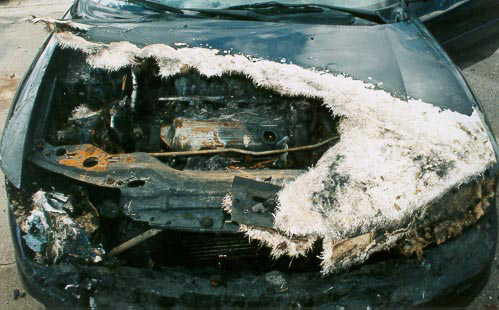TECHNICAL NOTEBOOK CELEBRATES ITíS 20TH ANNIVERSARY WITH CLAIMS MAGAZINEíS 50TH ANNIVERSARY
Congratulations to Claims Magazine on itís 50th year of publishing information for the claims industry. The Technical Notebook column started in 1982, with the first article on adjusting water damaged computer equipment, and was originally called Technically Speaking. During the 90ís the column name was changed to Technical Notebook, and presently, over 120 articles have been published in the areas of accident reconstruction, failure analysis, building losses, automobile losses and industrial claims.
The column tends to be pictorial in nature with concise explanations of photos from actual losses. The adage that a picture is worth a thousand words is especially true here because of the uniqueness and complexity of the subject matter. In keeping with Claims Magazineís 50th year, the following are examples of subject matter excerpted from the past 20 years of Technical Notebook.

Figure 1
Figure 1 is a view of a fractured control arm bolt found on the right rear suspension of an automobile after a rollover accident. Metallurgical analysis confirmed a defect in the bolt causing bolt fracture, severe misalignment of the right rear wheel and the rollover accident. Reckless driving charges against the driver were dropped after the defect analysis proved positive.

Figure 2
Fire departments and local authorities have been warning about the hazards of the older uncoated brass flexible connectors that are often subject to stress corrosion cracking and sudden leakage. Figure 2 shows such a crack that formed in an old connector that caused a natural gas leak, an explosion and total loss of a residential building.

Figure 3
In Figure 3, the radiator repair shop personnel forgot to put the radiator cap back on the vehicle, resulting in coolant being ejected onto the engine and an eventual fire. Ethylene glycol is a flammable liquid. Once the water it is mixed with boils off, ignition of the glycol vapor can occur from a variety of ignition sources in the vehicle.

Figure 4
Figure 4 is the view of the stern (back) of a vintage, wooden, cabin cruiser that sank at its mooring, despite the fact that the bilge pump was working at capacity. Apparently, the insured unsuccessfully repaired a hole in the stern with hardware store quality Styrofoam spray-on insulation.

Figure 5
A lightning strike on a home can cause intermittently high electrical currents to flow through a variety of conductors. It is not unusual to see metallic splatter from lightning related electrical current. Figure 5 shows a water heater where lightning attempted to jump a plumbing insulator from copper pipe to the iron fitting.

Figure 6
Figure 6 shows a pin hole from corrosive attack to a copper gas pipe near the foundation of a home. An explosion resulted from gas leakage, causing severe damage to the home. The corrosive attack was due to minerals in the soil reacting with the copper pipe.

Figure 7
Improper repair of automobiles can lead to fire losses as evidenced in Figure 7, a hastily repaired fuel line. Rather than replace the fuel line that broke during carburetor repair, the metal tube was cut and a rubber hose was substituted. Eventually the hose leaked from being cut on the sharp edges of the sawed off fuel tube.

Figure 8
The arrow in Figure 8 points to an improperly repaired support chain for a car on a carnival ride. The owner had purchased the ride used and repaired the support chain with a crimp style chain link from a hardware store. This link arrangement could not sustain the dynamic loading of the carnival ride and failed, causing a fatality.

Figure 9
Defective dryer temperature limit switches can pop out of their mounts and fail to sense the high temperatures associated with dryer operation. Figure 9 shows this limit switch (arrow), which had became detached in a dryer where a fire developed.

Figure 10
The8 reassembly of an engine after rebuilding was not totally completed before the construction vehicle was returned to the customer. The wiring support bracket, shown in Figure 10, had not been secured, and the starter electrical cable chafed against a fuel line. The insulation wore away, electric arcing drilled a hole in the fuel line, a fire started, and a total loss of the vehicle occurred.

Figure 11
Water heater gas valve failure can occur from improper gas pipe material selection. The incompatible pipe material reacts with the fuel gas and forms a contaminant that jams delicate valves as shown in Figure 11. This condition resulted in an explosion in a residential building and personal injury.

Figure 12
In some instances, lightning related current from a strike on a vehicle seeks ground through the tires. Figure 12 shows a burn hole in an automobile tire from a lightning strike.

Figure 13
Corrosion takes it toll on many vehicles as shown in Figure 13, a corrosion related failure of a vehicle frame.

Figure 14
A common loss during building construction is inadequate wind bracing during the building phase. Figure 14 illustrates building framing that collapsed during nominal wind conditions.
The purpose of the Technical Notebook column is to quickly familiarize claims professionals with the technical characteristics and failure modes of various pieces of hardware for coverage analysis as well as subrogation potential. Subject matter typically includes automotive technology, accident reconstruction, building problems, fire investigation, biomechanics, failure analysis, explosion investigation, industrial accidents and forensic sciences. All topics and photographs are obtained from actual losses. Thanks to Claims Magazine on their 50th anniversary and for the opportunity to share these real life examples with their loyal readers.













